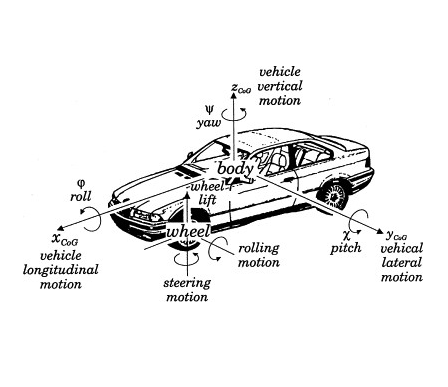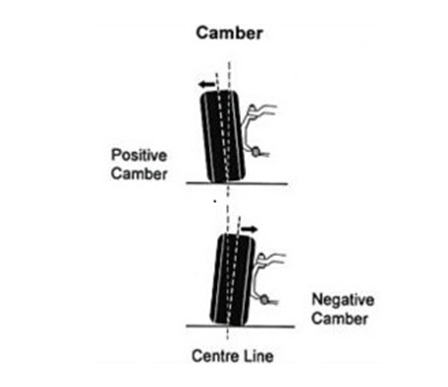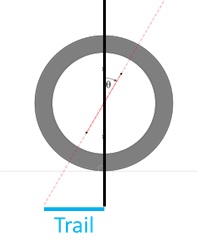
Vehicle dynamics
What is the vehicle dynamics: the vehicle driving dynamics is how force affected vehicle driving and comfort. The vehicle driving dynamics is divided into longitudinal dynamics and vertical dynamics, which includes driving, braking and ride comfort. The problem of driving slip and braking slip are solved by the study of vehicle longitudinal tire force, which can also improve driving and braking efficiency. The ride comfort focuses on vehicle vibration and pitch movement caused by vertical tire force.

Camber, longitudinal force
What is the camber: the camber angle is one of the angles made by the wheels of a vehicle; specifically, it is the angle between the vertical axis of a wheel and the vertical axis of the vehicle when viewed from the front or rear. It is used in the design of steering and suspension. If the top of the wheel is farther out than the bottom (that is, tilted away from the axle), it is called positive camber; if the bottom of the wheel is farther out than the top, it is called negative camber.

Camber angle alters the handling qualities of a particular suspension design; in particular, negative camber improves grip when cornering. This is because it places the tire at a better angle to the road, transmitting the centrifugal forces through the vertical plane of the tire rather than through a shear force across it.
The centrifugal (outwards) force is compensated for by applying negative camber, which turns the contact surface of the tire outwards to match, maximizing the contact patch area. Note that this is only true for the outside tire during the turn; on straight road only the inside tire is in contact with the road, this increasing the tyre wear. Caster angle will compensate this to a degree, as the top of the outside tire will tilt slightly inward and the inner tire will respectively tilt outward.
On the other hand, for maximum straight-line acceleration, the greatest traction will be attained when the camber angle is zero and the tread is flat on the road. Proper management of camber angle is a major factor in suspension design, and must incorporate not only idealized geometric models, but also real-life behavior of the components; flex, distortion, elasticity, etc. What was once an art has now become much more scientific with the use of computers, which can optimize all of the variables mathematically instead of relying on the designer's intuitive feel and experience.
Heavy-duty vehicles, can have more positive camber angle, so that when they are loaded and the whole vehicle lowers, the wheels are almost vertical.
Adjustability: in cars with multilink suspension, camber angle may be fixed or adjustable, but in MacPherson strut suspensions, it is normally fixed. The elimination of an available camber adjustment may reduce maintenance requirements, but if the car is lowered by use of shortened springs, the camber angle will change. Excessive camber angle can lead to increased tire wear and impaired handling. Significant suspension modifications may correspondingly require that the upper control arm or strut mounting points be altered to allow for some inward or outward movement, relative to the longitudinal centerline of the vehicle, for camber adjustment. Aftermarket plates with slots for strut mounts instead of merely holes are available for most of the commonly modified models of cars. There are certain other aftermarket solutions that allow the modification of the camber angle of the wheels.[1] Camber bolts with eccentrics allow adjustable camber on some vehicles. These bolts feature large washers that are either eccentric or offset. If the original-equipment bolts are replaced with eccentric ones, then the adjustment will engender a change of up to two degrees. Control arms (or A-arms) with adjustable ball joints represent another avenue for allowing side-by-side adjustability. With these control arms installed, tire camber can effectively be changed by simply moving the tires. After that, one tightens the bolts in order to lock the ball joint in the desired position. Yet another aftermarket solution for changing the camber angle is via control rods that are of adjustable length. However, this solution is only amenable to vehicles that employ control rods, not A-arms. Because control rods (in vehicles so equipped) are responsible for locating the suspension points and keeping them in place, therefore changing the overall length of the rods influences the camber angle.
What camber is used in road racing: the front camber angle is usually around 3.5 degrees from vertical with the rear set lower between zero and two degrees. In F1 the tyre supplier require teams to not exceed -3.5 degrees camber in front and -2.0 degrees on rear wheels

Source:
https://en.wikipedia.org/wiki/Camber_angle
https://the-race.com/formula-1/how-f1-teams-surprised-pirelli-with-legal-tyre-workarounds/
https://link.springer.com/article/10.1007/s40435-013-0032-y
edited by arrabbiata
Caster, longitudinal force
What is the caster: the caster angle is the angular displacement of the steering axis from the vertical axis of a steered wheel in a car, as seen from the side of the vehicle. The steering axis in a car with dual ball joint suspension is an imaginary line that runs through the center of the upper ball joint to the center of the lower ball joint.

θ is the caster angle, the red line is the pivot line or steering axis, and the grey area is the tire.
What is the trail: the trail is the side view horizontal distance from the ground intercept of the steering axis to the contact patch center of the tire. This distance is partly determined by caster angle, which is the side view inclination of the steering axis from vertical.
What is positive caster angle: the steering axis is angled such that a line drawn through it intersects the road surface slightly ahead of the center of the contact patch of the tire on the pavement by a distance called trail. The purpose of this is to provide a degree of self-centering for the steering—the wheel casters around in order to trail behind the axis of steering. Positive camber makes a vehicle easier to control and improves its directional stability (reducing its tendency to wander).

How is measured the caster: the caster angle is measured in degrees.
What is the effect of caster: the caster angle affect handling, increase caster improves its directional stability and improves camber gain in cornering. The downside is to have steering heavier and less responsive.
What is the camber gain from caster: when cornering, the vehicle weight shift is met with a maximization of the tire contact patch on the outside front wheel that’s under maximum cornering load. So, since the wheel rotates about a tilted axis, the wheel gains camber as it is turned. This effect is best visualized by imagining the unrealistically extreme case where the steering axis would be horizontal-as the steering wheel is turned, the road wheel would simply change camber rather than direction. This effect causes the outside wheel in a turn to gain negative camber, while the inside wheel gains positive camber. These camber changes are generally favorable for cornering, although it is possible to overdo it. In performance driving circles a caster increase – sometimes to the maximum available setting that the vehicle will accommodate – is credited with improvements in vehicle handling, maximum traction, and steering responsiveness.
Excessive caster angle will make the steering heavier and less responsive, although in racing large caster angles are used for improving camber gain in cornering. Caster angles over 7 degrees are common.
What caster angle is used in road racing: F1 cars can have more than 10 degrees positive caster
Source:
https://en.wikipedia.org/wiki/Caster_angle
https://www.presticebdt.com/caster-angle-explained-on-a-race-car/
https://suspensionsecrets.co.uk/caster/
edited by arrabbiata